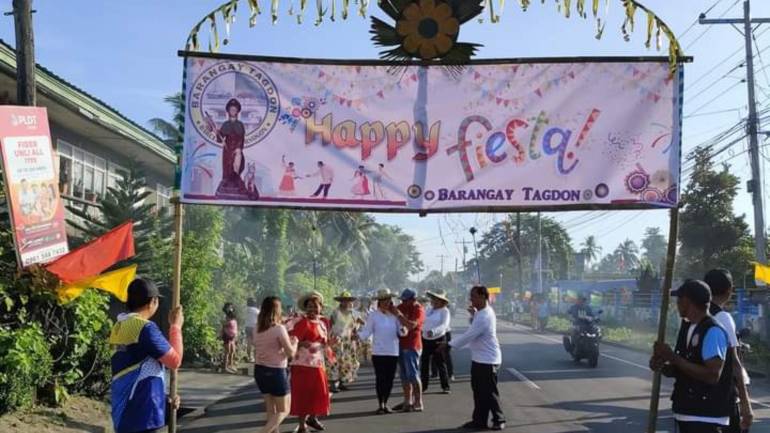San Roque: the patron saint of barangay Tagdon in Philippines

Barangay Tagdon, a coastal village more than 600 kilometers southeast of Manila, honors its patron San Roque with a thanksgiving festivity of food, drinks, dances, Masses, processions, and more.
The villagers usually prepare rice cakes, like suman and ibos, more than their guests can consume as their loved ones who come home for the annual fiesta will bring some when they go back to Manila and other parts of the country, or abroad.
At the reunions, laughter can explode more often and louder than the handclaps at videoke sessions.
Singing at a videoke is a deeply ingrained culture in the village.
Also, the sound that erupts from opening a bottle of beer and the action that comes with it, especially when using the tip of the spoon as an opener, can be epic after downing cold three.
But the revelry usually lasts longer than the official August 15-16 festivity.
The homecoming of probably more than a hundred from parts of the country and abroad bring home a fervor that could keep the village enlivened for a week or more.
After the official two-day feast, the villagers and their guests may dip in fresh water pools in resorts in Barcelona, which is the town of barangay Tagdon, or in neighboring towns.
This year's fun included, tug of war on the shore, Zumba at the alma mater, cultural street dance, and drum and lyre corps exhibition.
Thanks to San Roque, or Saint Roch, or Saint Rock to the English.
San Roque was a Majorcan Catholic confessor.
A confessor is a priest who hears the confessions of penitents and declares their forgiveness.
He was born in 1295 to a rich family in Montpellier, a city in southern France near the Mediterranean Sea. His father was a governor of this city.
Tradition says he was born with a birthmark of a red cross on his chest that grew as he did.
San Roque's father designated him governor of Montpellier before he died. But after his parents died when he was only 20 years old, San Roque gave away his wealth among the poor and joined the Franciscans.
As a friar, he cared for the sick in hospitals in Italy. Italy was struck by an epidemic plague at the time. After caring for many sick people, he got ill himself.
He decided to disappear into a forest. In the forest, he built a hut for himself.
A hunting dog came to the forest and saw the ailing Roch. The dog came over and over again bringing bread for him and licking his wounds.
One day, the owner of the dog followed into the forest and discovered Roch. He was Count Gottardo Pallastrelli, a nobleman.
Pallastrelli brought Roch to his home to recover. Thanks to the dog.
After he recovered from the disease, Roch decided to return to Montpellier. But the people could not recognize him now. His uncle was the governor of the city at the time. The authorities suspected he was a spy and arrested and put him in prison.
Roch spent five years in jail and died on August 16, 1327. He did not disclose his identity for reasons only he knew.
But only after his birthmark was revealed did the people finally recognize him. The son of the former governor. The one who distributed his wealth among the poor to become a mendicant.
San Roque is São Roque to the Portuguese, Sant Roc to the Catalans, San Rocco to the Italians, and St. Rollox in Glasgow, Scotland.
He is the patron saint of dogs, falsely accused people, surgeons, bachelors and the sick.
Radio Veritas Asia (RVA), a media platform of the Catholic Church, aims to share Christ. RVA started in 1969 as a continental Catholic radio station to serve Asian countries in their respective local language, thus earning the tag “the Voice of Asian Christianity.” Responding to the emerging context, RVA embraced media platforms to connect with the global Asian audience via its 21 language websites and various social media platforms.














